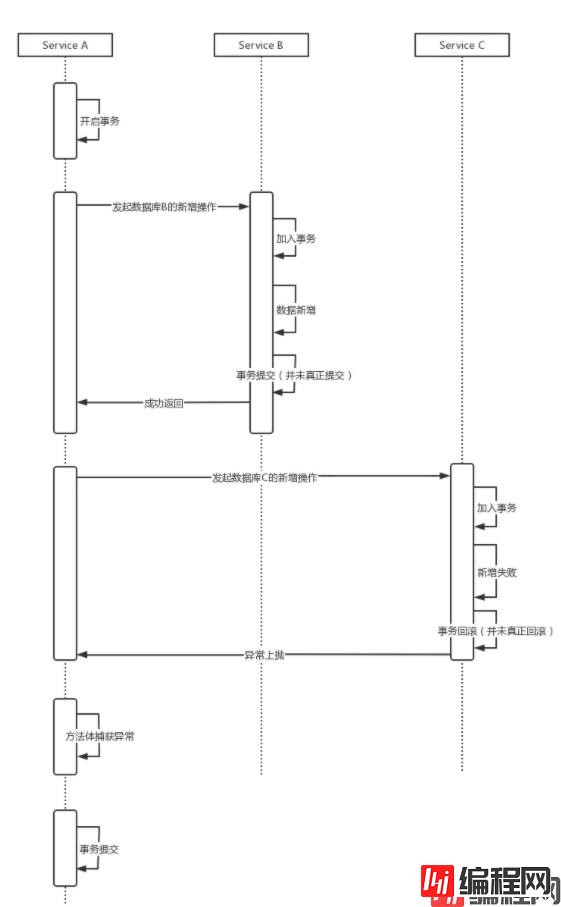Python 官方文档:入门教程 => 点击学习
目录前沿问题阐述知识点前置条件问题追踪总结前沿 一段生产事故发人深省,在spring的声明式事务中手动捕获异常,居然判定回滚了,这是什么操作?话不多说直接上代码 @Service p
一段生产事故发人深省,在spring的声明式事务中手动捕获异常,居然判定回滚了,这是什么操作?话不多说直接上代码
@Service
public class A {
@Autowired
private B b;
@Autowired
private C c;
@Transactional(propagation = Propagation.REQUIRED, isolation = Isolation.DEFAULT)
public void operate() {
try {
b.insertB();
c.insertC();
}catch (Exception e) {
e.printStackTrace();
}
}
}
@Service
public class B {
@Autowired
private BM bm;
@Transactional(propagation = Propagation.REQUIRED)
public int insertB() {
return bm.insert("B");
}
}
@Service
public class C {
@Autowired
private CM cm;
@Transactional(propagation = Propagation.REQUIRED)
public int insertC() {
return cm.insert("C");
}
}好了大家都看到上面这段代码了,在正常的情况的我们会往B表和C表中各插入一条数据,那么当代码出现异常时又会怎么样呢?
我们现在假设B插入数据成功,但是C插入数据失败了,此时异常会上抛到A,被A中operate方法的try - cache所捕获,正常来说此时数据库中B能插入一条记录,而C表插入失败,这是我们期望的情况,但事实却不是,实际情况是B表没有插入数据,C表也没有插入数据,也就是说整个操作被Spring给回滚了
注意点
如果代码稍稍变动一下,将try - cache放在insertC的代码块中,在同样的场景下,B中会成功插入一条记录
了解Spring的传播机制的可以直接跳过
我们先要搞清楚Spring中的REQUIRED的作用
REQUIRED:如果当前没有事务就创建一个新的事务,如果当前已经存在事务就加入到当前事务
也就是说当我们的传播机制同时为REQUIRED时,A、B、C三者的事务是共用一个的,只有当A的流程全部走完时才会做一次commit或者rollback操作,不会在执行B或者C的过程中进行commit和rollback
好,有了一定的知识储备,我们一起来看源码
我们首先找到Spring事务的代理入口TransactionInterceptor, 当我们通过调用A类中的operate方法时会调用TransactionInterceptor的invoke方法,这是整个事务的入口,我们直接看重点invoke中的invokeWithinTransaction方法
//获取事务属性类 AnnotationTransactionAttributeSource
TransactionAttributeSource tas = getTransactionAttributeSource();
//获取事务属性
final TransactionAttribute txAttr = (tas != null ? tas.getTransactionAttribute(method, targetClass) : null);
//获取事务管理器
final TransactionManager tm = determineTransactionManager(txAttr);
PlatfORMTransactionManager ptm = asPlatformTransactionManager(tm);
//获取joinpoint
final String joinpointIdentification = methodIdentification(method, targetClass, txAttr);
//注解事务会走这里
if (txAttr == null || !(ptm instanceof CallbackPreferringPlatformTransactionManager)) {
// Standard transaction demarcation with getTransaction and commit/rollback calls.
//开启事务
TransactionInfo txInfo = createTransactionIfNecessary(ptm, txAttr, joinpointIdentification);
Object retVal;
try {
// This is an around advice: Invoke the next interceptor in the chain.
// This will normally result in a target object being invoked.
retVal = invocation.proceedWithInvocation();
} catch (Throwable ex) {
// target invocation exception
//事务回滚
completeTransactionAfterThrowing(txInfo, ex);
throw ex;
} finally {
cleanupTransactionInfo(txInfo);
}
if (retVal != null && vavrPresent && VavrDelegate.isVavrTry(retVal)) {
// Set rollback-only in case of Vavr failure matching our rollback rules...
TransactionStatus status = txInfo.getTransactionStatus();
if (status != null && txAttr != null) {
retVal = VavrDelegate.evaluateTryFailure(retVal, txAttr, status);
}
}
//事务提交
commitTransactionAfterReturning(txInfo);
return retVal;
}不重要的代码我已经省略了,好我们来看这个流程,上面这段代码很明显反应出了,当我们程序执行过程中抛出了异常时会调用到completeTransactionAfterThrowing的回滚操作,如果没有发生异常最终会调用事务提交commitTransactionAfterReturning, 我们来分析一下

正常情况是C发生异常,并且执行到了completeTransactionAfterThrowing事务回滚,但是因为不是新创建的事务,而是加入的事务所以并不会触发回滚操作,而在A中捕获了该异常,并且最终走到commitTransactionAfterReturning事务提交,事实是这样的吗?
事实上就是这样的,那就奇怪了,我明明提交了,怎么反而回滚了,我们继续往下看
public final TransactionStatus getTransaction(@Nullable TransactionDefinition definition) throws TransactionException {
// Use defaults if no transaction definition given.
TransactionDefinition def = (definition != null ? definition : TransactionDefinition.withDefaults());
//重点看.. DataSourceTransactionObject拿到对象
Object transaction = doGetTransaction();
boolean debugEnabled = logger.isDebugEnabled();
//第一次进来connectionHolder为空的, 所以不存在事务
if (isExistingTransaction(transaction)) {
// Existing transaction found -> check propagation behavior to find out how to behave.
//如果不是第一次进来, 则会走这个逻辑
return handleExistingTransaction(def, transaction, debugEnabled);
}
// Check definition settings for new transaction.
if (def.getTimeout() < TransactionDefinition.TIMEOUT_DEFAULT) {
throw new InvalidTimeoutException("Invalid transaction timeout", def.getTimeout());
}
// No existing transaction found -> check propagation behavior to find out how to proceed.
if (def.getPropagationBehavior() == TransactionDefinition.PROPAGATION_MANDATORY) {
throw new IllegalTransactionStateException(
"No existing transaction found for transaction marked with propagation 'mandatory'");
}
//第一次进来大部分会走这里(传播属性是 Required | Requested New | Nested)
else if (def.getPropagationBehavior() == TransactionDefinition.PROPAGATION_REQUIRED ||
def.getPropagationBehavior() == TransactionDefinition.PROPAGATION_REQUIRES_NEW ||
def.getPropagationBehavior() == TransactionDefinition.PROPAGATION_NESTED) {
//先挂起
SuspendedResourcesHolder suspendedResources = suspend(null);
if (debugEnabled) {
logger.debug("Creating new transaction with name [" + def.getName() + "]: " + def);
}
try {
//开启事务
return startTransaction(def, transaction, debugEnabled, suspendedResources);
} catch (RuntimeException | Error ex) {
resume(null, suspendedResources);
throw ex;
}
} else {
// Create "empty" transaction: no actual transaction, but potentially synchronization.
if (def.getIsolationLevel() != TransactionDefinition.ISOLATION_DEFAULT && logger.isWarnEnabled()) {
logger.warn("Custom isolation level specified but no actual transaction initiated; " +
"isolation level will effectively be ignored: " + def);
}
boolean newSynchronization = (getTransactionSynchronization() == SYNCHRONIZATION_ALWAYS);
return prepareTransactionStatus(def, null, true, newSynchronization, debugEnabled, null);
}
}这段代码是开启事务的代码,我们来看,当我们A第一次走进来的时候,此时是没有事务的,所以isExistingTransaction方法不成立,往下走,因为我们的传播机制是REQUIRED,所以我们会走到startTransaction方法中
private TransactionStatus startTransaction(TransactionDefinition definition, Object transaction, boolean debugEnabled, @Nullable SuspendedResourcesHolder suspendedResources) {
boolean newSynchronization = (getTransactionSynchronization() != SYNCHRONIZATION_NEVER);
//创建一个新的事务状态, 注意这里的newTransaction 属性为true
DefaultTransactionStatus status = newTransactionStatus(
definition, transaction, true, newSynchronization, debugEnabled, suspendedResources);
//开启事务
doBegin(transaction, definition);
//开启事务后, 改变事务状态
prepareSynchronization(status, definition);
return status;
}好这里我们只需要关注一个点那就是newTransactionStatus的第三个参数newTransaction,只有当我们新创建一个事务的时候才会为true,这个属性很重要,我们后续还会用到它
好了,到这里第一次的事务开启就已经完成了,然后我们会调用业务逻辑,当调用insertB时,又会走到getTransaction,我们继续来看它,此时isExistingTransaction就可以拿到值了,因为A已经帮我们创建好了事务,此时会调用到handleExistingTransaction方法
//如果第二次进来还是PROPAFGATION_REQUIRED, 走这里, newTransation为false
return prepareTransactionStatus(definition, transaction, false, newSynchronization, debugEnabled, null);针对REQUIRED有用的代码就这一句,其他全部不用看,同样的我们看到第三个参数newTransaction,这里是false了,说明是加入了之前的事务,而不是自己新创建的,然后执行业务代码,最后走到commit,我们来看看commit中做了什么
//如果有回滚点
if (status.hasSavepoint()) {
if (status.isDebug()) {
logger.debug("Releasing transaction savepoint");
}
unexpectedRollback = status.isGlobalRollbackOnly();
status.releaseHeldSavepoint();
}
//如果是新事务, 则提交事务
else if (status.isNewTransaction()) {
if (status.isDebug()) {
logger.debug("Initiating transaction commit");
}
unexpectedRollback = status.isGlobalRollbackOnly();
doCommit(status);
}
else if (isFailEarlyOnGlobalRollbackOnly()) {
unexpectedRollback = status.isGlobalRollbackOnly();
}它什么事情都没有做,为什么?因为我们的newTransaction不为true,所以当我们的代码在operate方法全部执行完以后才会走到这里
好接下来我们来看insertC,前面的流程都一模一样,我们直接看到回滚代码
private void processRollback(DefaultTransactionStatus status, boolean unexpected) {
try {
boolean unexpectedRollback = unexpected;
try {
triggerBeforeCompletion(status);
if (status.hasSavepoint()) {
if (status.isDebug()) {
logger.debug("Rolling back transaction to savepoint");
}
status.rollbackToHeldSavepoint();
} else if (status.isNewTransaction()) {
if (status.isDebug()) {
logger.debug("Initiating transaction rollback");
}
doRollback(status);
} else {
// Participating in larger transaction
if (status.hasTransaction()) {
if (status.isLocalRollbackOnly() || isGlobalRollbackOnParticipationFailure()) {
if (status.isDebug()) {
logger.debug("Participating transaction failed - marking existing transaction as rollback-only");
}
doSetRollbackOnly(status);
} else {
if (status.isDebug()) {
logger.debug("Participating transaction failed - letting transaction originator decide on rollback");
}
}
} else {
logger.debug("Should roll back transaction but cannot - no transaction available");
}
// Unexpected rollback only matters here if we're asked to fail early
if (!isFailEarlyOnGlobalRollbackOnly()) {
unexpectedRollback = false;
}
}
} catch (RuntimeException | Error ex) {
triggerAfterCompletion(status, TransactionSynchronization.STATUS_UNKNOWN);
throw ex;
}
triggerAfterCompletion(status, TransactionSynchronization.STATUS_ROLLED_BACK);
// Raise UnexpectedRollbackException if we had a global rollback-only marker
if (unexpectedRollback) {
throw new UnexpectedRollbackException(
"Transaction rolled back because it has been marked as rollback-only");
}
} finally {
cleanupAfterCompletion(status);
}
}我们的insertC方法同样它的newTransaction不是true,所以最终会走到doSetRollbackOnly,这个方法重中之重,最后会调用这样一段代码
public void setRollbackOnly() {
this.rollbackOnly = true;
}然后我们就要执行到我们的关键代码A中的operate的提交代码了
public final void commit(TransactionStatus status) throws TransactionException {
if (status.isCompleted()) {
throw new IllegalTransactionStateException("Transaction is already completed - do not call commit or rollback more than once per transaction");
}
DefaultTransactionStatus defStatus = (DefaultTransactionStatus) status;
if (defStatus.isLocalRollbackOnly()) {
if (defStatus.isDebug()) {
logger.debug("Transactional code has requested rollback");
}
processRollback(defStatus, false);
return;
}
if (!shouldCommitOnGlobalRollbackOnly() && defStatus.isGlobalRollbackOnly()) {
if (defStatus.isDebug()) {
logger.debug("Global transaction is marked as rollback-only but transactional code requested commit");
}
processRollback(defStatus, true);
return;
}
//执行事务提交
processCommit(defStatus);
}好了,看到这大家都明白了吧,在commit中,Spring会去判断defStatus.isGlobalRollbackOnly有没有抛出过异常被Spring所拦截,如果有,那么就不会执行commit操作,转而执行processRollback回滚操作
在Spring的REQUIRED中,只要异常被Spring捕获到过,那么Spring最终就会回滚整个事务,即使自己在业务中已经捕获
所以我们回到最初的代码,如果我们希望Spring不进行回滚,那么我们只用将try-cache方法insertC方法中就可以,因为此时抛出的异常并不会被Spring所拦截到
到此这篇关于Spring事务捕获异常后依旧回滚的解决的文章就介绍到这了,更多相关Spring事务捕获异常后回滚 内容请搜索编程网以前的文章或继续浏览下面的相关文章希望大家以后多多支持编程网!
--结束END--
本文标题: Spring事务捕获异常后依旧回滚的解决
本文链接: https://www.lsjlt.com/news/162506.html(转载时请注明来源链接)
有问题或投稿请发送至: 邮箱/279061341@qq.com QQ/279061341
下载Word文档到电脑,方便收藏和打印~
2024-03-01
2024-03-01
2024-03-01
2024-02-29
2024-02-29
2024-02-29
2024-02-29
2024-02-29
2024-02-29
2024-02-29
回答
回答
回答
回答
回答
回答
回答
回答
回答
回答
0